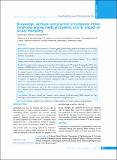Please use this identifier to cite or link to this item:
https://hdl.handle.net/20.500.14356/1548Full metadata record
| DC Field | Value | Language |
|---|---|---|
| dc.contributor.author | Sitaula, Ranju Kharel | - |
| dc.contributor.author | Khatri, Anadi | - |
| dc.date.accessioned | 2023-05-16T05:38:51Z | - |
| dc.date.available | 2023-05-16T05:38:51Z | - |
| dc.date.issued | 2018 | - |
| dc.identifier.citation | Kharel (Sitaula)R., & KhatriA. (2018). Knowledge, Attitude and practice of Computer Vision Syndrome among medical students and its impact on ocular morbidity. Journal of Nepal Health Research Council, 16(3), 291-296. https://doi.org/10.33314/jnhrc.v16i3.1177 | en_US |
| dc.identifier.issn | Print ISSN: 1727-5482; Online ISSN: 1999-6217 | - |
| dc.identifier.uri | http://103.69.126.140:8080/handle/20.500.14356/1548 | - |
| dc.description | Original Article | en_US |
| dc.description.abstract | Abstract Background: Computer vision syndrome is a common global problem among millions of computer users including medical students. Medical students are preferring soft copies rather than textbooks. The aim of this study was to assess the knowledge, attitude, and practice of MBBS students about Computer vision syndrome, and to identify its ocular morbidity among them. Methods: A descriptive cross-sectional survey based on the questionnaire was conducted among 1st- 4th year MBBS students of the Institute of Medicine and 80 students underwent detailed ocular evaluation. Results: A complete survey response was received from 236 students out of 299 students (Response Rate 80%). The mean age of MBBS students was 21.38 years ± 1.328 years and the range were 19-22 years; 76.2% were male and 23.8% were female. The majority (37.2%) spent 2-3 hours/day on the computer and had a higher risk (p-0.0001) of developing Computer vision syndrome. About 69.5% students used a computer at the level of the eye but there was a significant reduction in Computer vision syndrome (p-0.0001) among those who had computer screen below the eye level. Association between taking breaks (p-0.0001) and frequent blinking (p-0.0411) during computer use and relief of symptoms was significant. Only 22.9% had pre-existing knowledge of Computer vision syndrome and only 25.5% of them were practicing the ideal viewing distance. Among 80 medical students randomly selected for detail eye examinations (63.7% male;36.2% female), the prevalence of Computer vision syndrome was 71.6%. The commonest ocular complaint was a headache (50%) and dry eyes (45%). Myopia was the commonest refractive error (31.2%) and the orthoptic problem was prevalent among 17.5% students. Conclusions: The survey showed that Computer vision syndrome is relevant among MBBS students but the knowledge, attitude, and practice of Computer vision syndrome among them is poor. Keywords: Attitude; computer vision syndrome; eyestrain; headache; knowledge; practice; medical students. | en_US |
| dc.language.iso | en | en_US |
| dc.publisher | Nepal Health Research Council | en_US |
| dc.relation.ispartofseries | Jul-Sep 2018;1177 | - |
| dc.subject | Attitude | en_US |
| dc.subject | Computer vision syndrome | en_US |
| dc.subject | Eyestrain | en_US |
| dc.subject | Headache | en_US |
| dc.subject | Knowledge | en_US |
| dc.subject | Practice | en_US |
| dc.subject | Medical students | en_US |
| dc.title | Knowledge, Attitude and practice of Computer Vision Syndrome among medical students and its impact on ocular morbidity | en_US |
| dc.type | Journal Article | en_US |
| local.journal.category | Original Article | - |
| Appears in Collections: | Vol. 16 No. 3 Issue 40 Jul - Sep 2018 | |
Files in This Item:
| File | Description | Size | Format | |
|---|---|---|---|---|
| 1177-Manuscript-6639-1-10-20181030.pdf | 237.06 kB | Adobe PDF |  View/Open |
Items in DSpace are protected by copyright, with all rights reserved, unless otherwise indicated.
